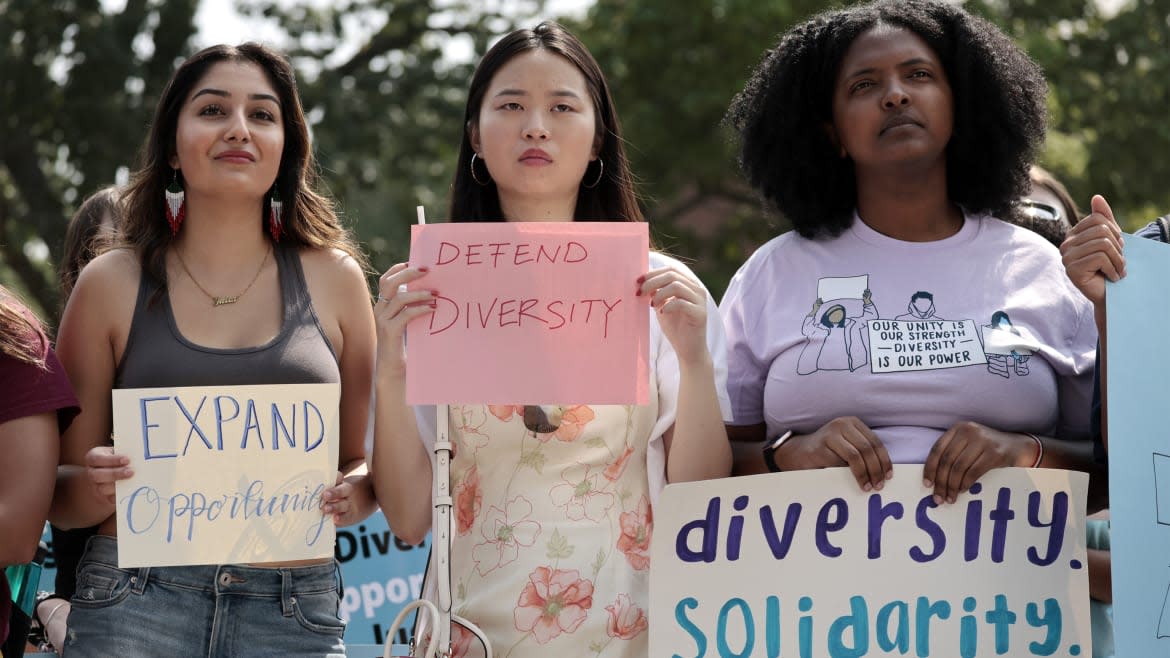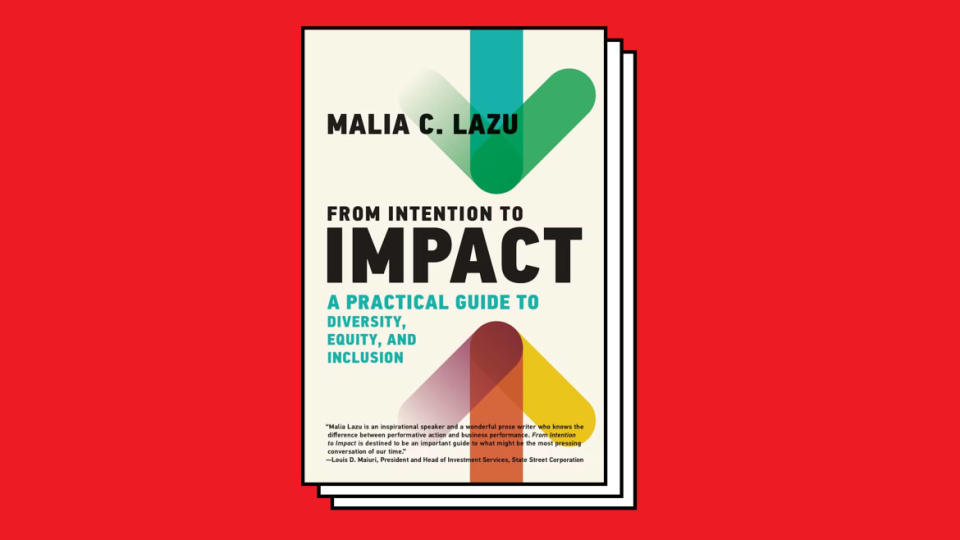Destroying DEI Is a Death Sentence for American Prosperity

- Oops!Something went wrong.Please try again later.
Diversity, equity, and inclusion (DEI) is facing its most formidable challenges in recent memory. The 2023 Supreme Court ruling against affirmative action on college campuses opened the door for more than 20 states to reverse the course on DEI. In what it called a “backlash against ‘wokeism,’” The New York Times observed that “the eradication of D.E.I. programs has become both a cause and message suffusing the American right.”
The loss of yet another generation of people of color to bias, exclusion, and racism is too high a price. But there is another cost as well: $16 trillion. This comes from a Citibank report, which estimated that if four key gaps experienced by Blacks—in wages, education, housing, and investment—had been closed 20 years earlier, the U.S. GDP would see a $5 trillion increase over the next five years.
The GOP Hates the Social Safety Net, but Their Voters Need It
Even though companies supposedly recognize that “diversity is good for business,” racism remains entrenched in the corporate world, just as it is in American society. It’s time to evolve—or die.
An Investment in Equity
Capitalism is a philosophy, and like all good philosophies, it evolves with the times. Founding economic thought leaders such as Adam Smith and John Stuart Mill were aiming to define a new way forward based on individual rights, private ownership, and industrialism. The hypocrisy and weakness in this philosophy are exposed by the growth of capitalism based on stealing land and owning individuals. Even Adam Smith saw the power dynamics when he observed, “The persons who make all the laws in that country are persons who have slaves themselves. These will never make any laws mitigating their usage; whatever laws are made with regard to slaves are intended to strengthen the authority of the masters and reduce the slaves to a more absolute subjection.” It is in this hypocrisy that we see our evolution with the idea that capitalism can be more than extractive.
The challenge, however, is that corporate leaders may not know how to change or respond to these new expectations. In addition to the fear of getting it catastrophically wrong, there is a gap between intention and impact into which many executives have fallen. It’s no surprise that their DEI efforts have become largely a series of checkboxes forced on middle managers, while excluded communities are blamed for the efforts not working.
Social Justice Clawbacks
To understand how to respond to this moment, we first must understand how we got here. While the narrative starts centuries ago when all those European philosophers were figuring out how to be free, we will focus on recent American history to see the cycles that push the country toward justice. The 1980s is the decade in which most millennials were born and the era that shaped their childhoods. The country was healing from the civil rights movement wins and murders, a presidential resignation, and an oil crisis. Affirmative action and other results of the civil rights movement were being scrutinized as overreaching and unsustainable. White society was ready to claw back the gains made by people of color generally and Black people in particular.
Taking the race playbook from Barry Goldwater’s presidential run in 1964, Ronald Reagan entered national politics with a Republican National Committee (RNC) slogan that might sound familiar: Let’s Make America Great Again. The RNC used the fear of losing a white, male-dominated society as a campaign message, putting gains for minorities in the crosshairs. Reagan’s legacy became one of civil rights rollbacks, draconian drug laws featuring mandatory minimum sentences, and a widening of the wealth gap. The policies of Reagan actively dismantled the legislative wins of the civil rights movement and took actions such as supporting seniority over diversity goals, waging a racist war on drugs, and creating the welfare queen narrative, which dehumanized working-class Black women.

If the Reagan administration was the end of the New Deal era, then the 2008 financial crisis marked the beginning of the end of over-romanticizing Reaganomics and scapegoating people of color. Americans were ready for a real conversation about what’s next. Yet what came next was disappointing for Main Street: When Wall Street got bailed out, America found out some banks were “too big to fail,” even as families lost homes and retirement savings.
Cut to the summer of 2010. It was a busy one for direct action organizers. Tired of watching Wall Street recover at the expense of Main Street, anticonsumerism organizations were about to launch a movement that would change how we talk about class in America. The growing tension culminated on September 17, 2011, when over 1,000 people joined the call to march to the opening bell of the stock exchange after gathering in Zuccotti Park and then continued to occupy the park for two months. In a few weeks, the world would see this tactic used around the globe to call attention to wealth inequality.
Millions of people globally occupied their economic centers, including hundreds of thousands in cities around the United States. Occupy Wall Street reinvigorated direct action and a class conversation for the fed-up 99 percent. Unions, social justice organizers, and class activists joined forces again to reignite consumer activism. Occupy, whose story is often told as one of failure, actually marks a new dawn of tactical organizing that would be a catalyzing force toward evolving capitalism in the twenty-first century.
A movement against systemic oppression was ready to break new ground. Police killing Black people is nothing new, but more people were paying attention and becoming outraged. Three young Black women, Alicia Garza, Opal Tometi, and Patrisse Cullors, started a hashtag on Twitter that would go on to become the rallying cry for an end to the state-sanctioned police killing of Black people. #BlackLivesMatter was a call for dignity in response to George Zimmerman claiming self-defense and subsequently being found not guilty in the 2012 shooting death of Trayvon Martin, a child holding Skittles. It continued to be used to express love for Black life after Michael Brown was killed by a police officer and his body remained lying in the street, uncovered, for hours.
Then in 2020, COVID-19 stopped us all in our tracks, literally. The virus destroyed much, but sadly not racism. Alongside the souls claimed by the pandemic, the inaction to stop oppression in our society claimed the lives of George Floyd, Breonna Taylor, Ahmaud Aubery, and so many more publicly lynched people. So even in the middle of a global pandemic, the movement could not and did not stop. The spirit of activism is alive and well, and corporate America will soon face greater accountability.
Corporations have been spurred to action by consumer pressure. They have made bold commitments to address all manner of social ills, including the extreme socioeconomic imbalance in the United States.
America is not changing; it has changed. Consumers are holding corporations to a higher level of accountability as a result of the desire to innovate toward a more equitable culture. The question is, how well do corporations understand what is being asked of them in this moment of cultural shift? CEOs can be trailblazers instead of roadblocks to this new society.
Adapted from From Intention to Impact: A Practical Guide to Diversity, Equity, and Inclusion by Malia Lazu (MIT Press).
Get the Daily Beast's biggest scoops and scandals delivered right to your inbox. Sign up now.
Stay informed and gain unlimited access to the Daily Beast's unmatched reporting. Subscribe now.

